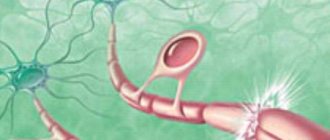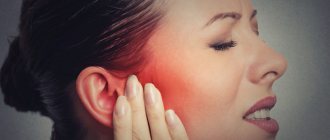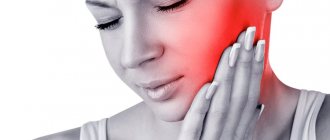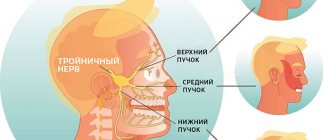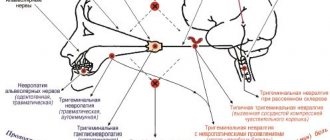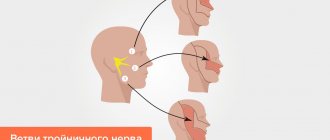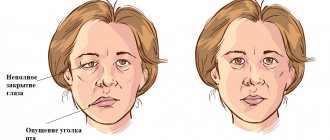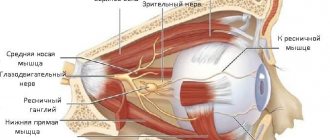Signs of trigeminal neuralgia
A typical symptom of trigeminal neuralgia is prosopathy - facial pain. The sensation can be compared to an electric shock. Pain of a paroxysmal nature lasts 5-15 seconds and occurs abruptly. It is usually localized in the area of the lower jaw and cheekbones, but can appear in any part of the face. Neuralgia in severe form leads to partial or even complete loss of sensitivity.
Other symptoms:
- nervous eyelid tic;
- impaired coordination of movements;
- increased body temperature;
- headache;
- chills, fever;
- general weakness.
Tooth pain due to neuralgia, causes and treatment
The presence of toothache does not always indicate problems with the teeth and oral cavity. Sometimes tooth pain can occur in people with completely healthy teeth. In this case, there is a possibility that toothache is a symptom of trigeminal neuralgia, which is hidden behind such pain, making it difficult to identify the real cause of the ailment.
The trigeminal nerve is one of twelve pairs of cranial nerves, which is a continuation of the spinal cord and is responsible for the functioning of many reflexes, such as blinking, sneezing, and eyebrow movements. Also, together with others, this nerve ensures normal breathing. The trigeminal nerve consists of three branches that form it: the first branch is located at eye level, the second above the upper jaw near the nose, and the third in the lower jaw.
There are two types of trigeminal neuralgia - true and secondary. True or primary neuralgia is a self-limiting disease, while secondary neuralgia develops due to the presence of complications of other diseases. The type of inflammation can be determined based on a number of reasons that caused the development of trigeminal neuralgia.
Reasons for the development of true neuralgia:
- displacement of arteries and veins;
- the presence of adhesions or tumors;
- injury to the face.
Causes of secondary neuralgia:
- gingivitis;
- pulpitis;
- periodontitis;
- periostitis;
- after tooth extraction:
- dental caries;
- in the presence of ENT diseases;
- in case of metabolic disorders;
- after hypothermia, etc.
The manifestations of symptoms of trigeminal neuralgia depend on which branch is affected. Toothache, as well as pain in various areas of the head, occurs when the second and third branches become inflamed. However, the nature of the pain differs depending on the inflamed branch, which helps to determine the affected area. With neuralgia of the second branch of the trigeminal nerve, pain manifests itself in the area of the nose, facial muscles and the entire upper row of teeth, while, as with inflammation of the third branch, pain in the neck, chin, cheeks, and lower teeth is characteristic.
The main symptoms of inflammation of the trigeminal nerve:
- paroxysmal toothache, radiating deep into the bones;
- spasm of the facial muscles during an attack;
- discomfort when eating hot or cold food, when brushing your teeth, as well as when touching your face, etc.
If you experience toothache associated with neuralgia, you must consult a doctor. However, if the pain is due to inflammation of the trigeminal nerve, your dentist will most likely not be able to help you. For qualified help, you need to go to a neurologist to avoid the development of complications and not to aggravate the situation.
Causes of neuralgia
Unlike neuritis, which is an inflammatory disease, neuralgia is not. Neuritis develops against the background of a virus and infection. Neuralgia occurs due to mechanical effects on the trigeminal nerve, provoked by various factors.
- Head injuries with displacement of the skull bones.
- Tumors of various etiologies, which, as they grow, compress the trigeminal nerve.
- Bite defects and other anomalies of the dentofacial area.
- Diseases of blood vessels located in close proximity to the trigeminal nerve.
- Chronic sinusitis and otitis.
- Medical error during tooth extraction.
- Neuralgia can be triggered by infections, including periodontitis, stomatitis, herpes, and syphilis.
Hypothermia does not cause neuralgia, but makes treatment difficult. Neurosis, metabolic disorders, diabetes mellitus and other chronic pathologies have a negative effect on therapy.
Symptoms
The leading symptom of trigeminal neuralgia is pain, which patients describe as an electric shock or lightning strike. A painful attack provokes lacrimation, numbness, dilated pupils; fainting is also possible. Pain sensations spread to the entire half of the face, covering it completely, including the skin, eye, cheek, teeth, lips.
Main characteristics of a painful attack:
| Start | Sudden, provoked by a trigger (washing, chewing) |
| Character |
|
| Localization | When the first branch is affected, the following pain occurs:
When the second branch is damaged, it hurts
When the third branch is involved in the process, it hurts
|
| Radiation of pain | Absent, no impact to the ear, tongue or neck |
| Duration | The attack lasts from several seconds/minutes to several hours, rarely the pain is constant. The long-term existence of the pathology leads to an increase in the duration of attacks. |
| External signs | Numbness, silence (it hurts to speak), redness of the skin. |
A painful attack is accompanied by a group of symptoms:
| Movement disorders |
|
| Vegetative-trophic disorders |
|
| General disorders |
|
In the absence of timely and adequate treatment, a pathological focus of pain activity is formed in the thalamus, which aggravates the course of the pathology:
- pain covers the entire half of the face;
- slight touching of the face leads to an attack;
- bright light, sharp sound provoke an attack;
- the memory of an attack can trigger a new one;
- transformation of pain from paroxysmal to constant;
- increased vegetative-trophic disorders.
The difference between a toothache and an attack of trigeminal neuralgia
Often, patients with an attack of trigeminal neuralgia turn to the dentist because they have a reaction to cold/hot.
Signs of odontogenic (tooth) pain, uncharacteristic of neuralgia:
- toothache is long-lasting and does not have a sudden onset and end (with a trigeminal attack, the pain is compared to an electric discharge, and in the intervals between paroxysms there is no discomfort);
- taking analgesics relieves toothache, but is useless for neuralgia;
- odontogenic pain occurs at any time of the day, usually at night, and trigeminal pain often develops during the day.
Types of neuralgia
Neuralgia that develops as a result of viruses and other diseases is called secondary. Primary or idiopathic is a disease caused by compression of a nerve. According to localization, it can be unilateral or bilateral. With unilateral neuralgia, one branch of the nerve is affected, with bilateral neuralgia, several.
According to the nature of the disease, it can be acute or chronic. With acute neuralgia, the patient experiences frequent and severe pain. If the pathology is not treated, it goes into a chronic stage, when exacerbation is replaced by periods of remission.
Postherpetic neuralgia develops after herpes and differs from the classic nature of the pain, which may not go away for several hours. An atypical form of neuralgia is a psychosomatic disease, which can be triggered by stress, depression, and nervous exhaustion.
Methods for diagnosing neuralgia
The disease is diagnosed using different methods that make it possible to establish its cause:
- visual examination and questioning of the patient;
- radiography;
- MRI of the head;
- biochemical studies of blood and urine;
- electromyography.
To clarify the diagnosis, the neurologist often turns to doctors of other specialties - otolaryngologist, ophthalmologist, orthodontist. This is done to exclude diseases for which the same symptoms are typical.
Drug treatment of neuralgia
Effective treatment is only possible with the use of a comprehensive drug regimen. Anticonvulsants are prescribed first. Antihistamines and local analgesics are sometimes added to them to relieve acute attacks of pain. The deficiency of gamma-aminobutyric acid will be compensated by phenibut and similar neotropic drugs. In case of exacerbation, antidepressants may be prescribed. If the disease is caused by a viral infection, the patient is prescribed non-steroidal antiviral and antibacterial drugs.
Other treatments
To eliminate pain, physiotherapeutic procedures are prescribed: acupuncture, magnetic therapy, ultraphonophoresis. A good addition to drug treatment is head and face massage. If conservative treatment methods do not bring the desired effect, the patient may be prescribed a minimally invasive operation - microsurgical decompression, radiosurgery or percutaneous destruction.
Trigeminal neuralgia is not only painful, but also causes problems with the patient’s communication abilities. Constantly expecting attacks of pain, a person isolates himself from others, withdraws into himself, becomes irritable and depressed. The prognosis for treatment is favorable. The chances of a full recovery increase when the patient consults a doctor at an early stage of the development of neuralgia, when the first symptoms appear.
Causes
To date, the exact trigger of the pathology has not been established; trigeminal neuralgia is an idiopathic disease. However, more than 50 factors have been identified that contribute to the occurrence of the disease.
Factors that provoke the onset of trigeminal neuralgia
Compression of the trigeminus in the skull or its branches at the exit from it:
- pathology of cerebral vessels: vasodilatation, tortuosity or aneurysms,
- atherosclerotic lesions,
- strokes,
- hypertonic disease,
- increase in intracranial pressure as a consequence of traumatic brain injury, damage to the cervical spine, rarely - cervical osteochondrosis;
Viral infection:
- postherpetic trigeminal neuralgia,
- after suffering from polio,
- as a consequence of neuro-AIDS.
Nervous system diseases:
- multiple sclerosis;
- meningitis, encephalitis with damage to the meninges;
- cerebral palsy;
- cysts, brain tumors;
- epilepsy;
- post-traumatic, post-infectious, post-hypoxic encephalopathy.
Dental reasons:
- poor-quality deep filling of teeth, tooth extraction, operations on the face and oral area;
- adverse reaction to anesthesia during dental treatment;
- jaw injury combined with dental injury;
- periostitis (“flux”);
- gingivitis, pulpitis, abscess in the oral area.
In addition, the risk of pathology increases significantly in the presence of the following circumstances:
- age over 50 years;
- mental disorders;
- hypothermia of the face;
- deficiency of B vitamins (necessary for the nervous system);
- metabolic disorders (gout, pathologies of the thyroid gland, adrenal glands);
- helminthic infestations;
- bulimia/anorexia, “therapeutic” fasting;
- sinusitis, sinusitis, frontal sinusitis;
- osteomyelitis of the upper/lower jaw;
- autoimmune pathology (systemic lupus erythematosus, scleroderma);
- diseases of an allergic nature (bronchial asthma, hay fever);
- acute and chronic infections (malaria, tuberculosis).
Factors provoking a pain attack
Paroxysms of pain occur when the trigeminus is irritated in the “trigger” (trigger) zones - these are the wings of the nose, eyelids, nasolabial folds. Provoking factors are:
- shaving;
- makeup;
- touching the face;
- teeth cleaning;
- washing;
- change in facial expressions (crying, laughing, raised/furrowed eyebrows, smiling);
- action of masticatory muscles (chewing);
- gust of wind;
- change in temperature (for example, after leaving the room in the cold or vice versa).
